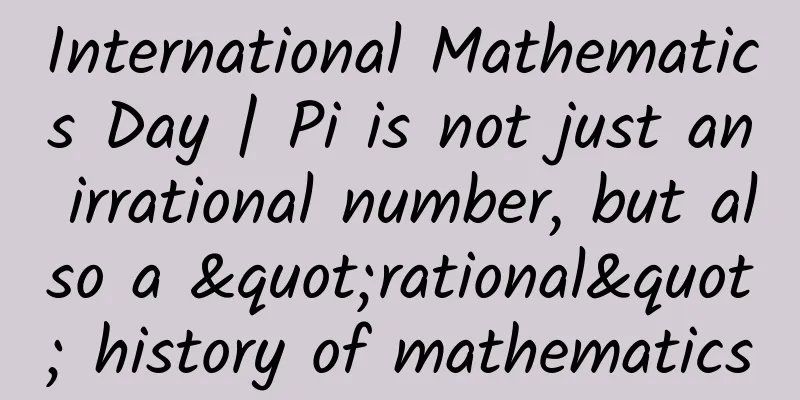International Mathematics Day | Pi is not just an irrational number, but also a "rational" history of mathematics

|
On November 26, 2019, UNESCO approved the announcement at its 40th General Conference that March 14th would be the International Day of Mathematics. The reason why the International Day of Mathematics is set on March 14th is because "3.14" is the number closest to the value of pi, so many people also call this day "International Pi Day". Today, let's join in the fun and talk about the mathematical history behind pi around the world. π (copyrighted image from the gallery, reprinting may cause copyright disputes) 01 Ancient Egypt: The Pyramids That Squared the Circle For thousands of years, humans have been searching for the true value of pi. Ancient civilizations around the world have been calculating pi since the Bronze Age at the latest. The Rhind Papyrus, written around 1650 BC, is a famous ancient Egyptian mathematics book. Question 50 in the book asks: "Try to find the area of a circle with a diameter of 9?" The answer is: subtract 1/9 of the diameter and square it. In other words, the area of the circle is 64. This answer can be used to infer that the value of pi at that time was about 3.16. However, strangely, the ancient Egyptian pyramid of Khufu, which was built about 900 years earlier than this book, had already used a more accurate numerical value of pi in its engineering design: the pyramid of Khufu is the largest ancient building in existence. It was built around 2560 BC, with an original height of 146.59 meters and a base of a square with a side length of 230.37 meters. Is such a building size based on any proportional rule? To solve this mystery, we must go back to a measurement unit in ancient Egypt - the cubit (also known as the wrist ruler). The length of the cubit is based on the distance from the elbow to the top of the middle finger of an adult. According to the Egyptian cubit tools unearthed today, its length is about 52.35 cm. The Pyramid of Khufu (copyright image from the gallery; reprinting may lead to copyright disputes) The height and base length of the Great Pyramid of Khufu may seem confusing, but if expressed in cubits, they are exactly 280 and 440 cubits, two beautiful integers. In addition to integers, if the side length is divided by 2 times the height of the pyramid, it is exactly equal to 3.1416. Therefore, the circumference of the circle with the height of the pyramid as the radius is exactly equal to the circumference of the square base. This can be said to be the circumference version of "squaring the circle", which is really ingenious! But some scholars suspect that this π/2 ratio is just a coincidence, because as mentioned earlier, the ancient Egyptians knew pi to be 3.16. But some scholars believe that the Rhind Papyrus is just one of many ancient Egyptian mathematical documents, and it is not ruled out that Egypt already had other more accurate approximations of pi. Moreover, the Egyptians built dozens of pyramids. If we take a step back and look at other pyramids, we will find that their sizes are different, but the overall design is roughly similar, and the base-to-height ratio is usually close to pi, but not as accurate as the Pyramid of Khufu. The ancient Romans, who lived at about the same time as the Egyptians, also had knowledge of pi. A Babylonian stone tablet from 1900 BC clearly records that pi = 25/8 = 3.125. The ancient Indian religious masterpiece "The Hundred Paths Brahmastra", written between 800 and 600 BC, records that pi is equal to the fraction 339/108, which is about 3.139. However, these are obviously rough life experience values, not the results of strict calculations. 02 Ancient Rome: At the last moment, Archimedes only thought about "circle" Around 250 BC, the ancient Greek mathematician Archimedes proposed the first algorithm to approximate pi: starting from the unit circle, Archimedes first used an inscribed regular hexagon to find that the lower bound of pi was 3, and then used a circumscribed regular hexagon and the Pythagorean theorem to find that the upper bound of pi was less than 4. He then continued to inscribe regular polygons with more sides until he found an inscribed regular 96-gon and a circumscribed regular 96-gon. Finally, he found that the lower and upper bounds of pi were 223/71 and 22/7, respectively, and took their average value of 3.141851 as the approximate value of pi. Archimedes devoted his entire life to pi, and even calculated it before his death. Legend has it that in 212 BC, when the Roman army invaded Greece, Archimedes was kneeling on the ground concentrating on calculating pi. Suddenly a soldier rushed over, and wanted to take him away to serve Rome on the orders of the Roman general. As a result, Archimedes, who was immersed in mathematics, just drove the soldier away and said, "Don't step on the circle I drew." The Roman soldier was furious and killed Archimedes despite the general's order not to harm scholars. Archimedes stained the history of pi with his blood and defended the dignity of pi with his life. In order to commemorate his outstanding contribution to pi, later generations also called pi the "Archimedes constant." The Death of Archimedes (copyright image from the library, reprinting may cause copyright disputes) However, Rome did inherit ancient Greek mathematics. Around 150 AD, Ptolemy of Rome made some additional calculations based on Archimedes's calculations and found that 377/120 was approximately equal to 3.14167. The Romans preferred circles. Today, the famous ancient building in Italy, the Colosseum, is a huge circle. 03 Ancient China: The most accurate records for thousands of years Then, more than 100 years later, the Chinese rushed into the journey of approximating pi. In fact, as early as the second half of the first century AD, the mathematical monograph "Nine Chapters on the Mathematical Art" proposed a rough value of pi of 3. In 265 AD, the Southern Dynasty mathematician Liu Hui invented a scientific method for calculating pi, "the method of dividing a circle", and concluded that pi is approximately equal to 3927/1250=3.1416, accurate to 4 decimal places. Liu Hui's "circle-slicing method" is similar to Archimedes' iterative algorithm. He used the perimeter of a regular polygon inscribed in a circle to approximate the circumference of a circle, and calculated the area of a 96-gon inscribed in a circle. In 480 AD, Zu Chongzhi continued to use Liu Hui's algorithm to calculate the area of a 12288-gon, and then extended it to the area of a 24576-gon, and obtained the secret law 355/113≈3.1415929, reaching 7 decimal places of precision, which is a precision that most industries today do not need - Zu Chongzhi kept the world record for the most accurate value of pi for 1,000 years! The ancient Chinese were so familiar with and good at calculating pi that they naturally applied it in architecture. There are countless circular ancient buildings, from the Temple of Heaven in Beijing to the Tulou in Fujian, all of which demonstrate the ancients' precise control of pi. Temple of Heaven Hall of Prayer for Good Harvests (Source: Xinhua News Agency) There is also a Jianshui Wenbi Tower in Honghe Prefecture, Yunnan, which was built during the Daoguang period of the Qing Dynasty and is nicknamed the "Pi Tower". The Jianshui Wenbi Tower is 31.4 meters high. The perimeter of the tower base is also 31.4 meters, which is exactly the same as the tower's height. And this number is so close to pi that people can't help but wonder if this was intentional by the ancients. However, some scholars pointed out that the current meter system was not used during the Daoguang period, and one foot in the Ming Dynasty was about 31.1 centimeters today, and one foot in the Qing Dynasty was about 32 centimeters today. The initial height of the Jianshui Wenbi Tower should be 100 feet, that is, 10 zhang, which may be the original intention of the tower's height. Jianshui Wenbi Tower, known as the "Pi Tower" (copyright image from the gallery, reprinting may cause copyright disputes) However, Wang Nan, a scholar of ancient architecture in my country, pointed out that among the many ancient towers in China, many have a height-to-width ratio close to pi. This is not a coincidence, but a careful design that contains the ancients' "round sky and square earth" cosmology. The concept of "round sky and square earth" appeared in my country very early, referring to the method of measuring the sky and the earth. "Round sky" means that the sky must be measured with the degree of "circle", that is, pi. The "three" in the ancient saying "three heavens and two earths" refers to the approximate value of pi; "square" means that the earth must be measured with "square", and "two earths" means "square", which refers to the calculation method of multiplying the length of a side by the length of a side. 04 Constantly breaking records! The "international race" of pi calculation Back to the calculation of pi, the Chinese "contestant" Zu Chongzhi held the record for a thousand years, and it was not until the 15th century that the Indian mathematician Madhahava broke it: he calculated pi to 10 decimal places. Then the Persian astronomer Ghiyasuddin inherited his algorithm and pushed the accuracy to 16 places, reaching the highest accuracy required for modern aerospace. Indian digital mathematics spread to Europe through the Arabs, and missionaries in the Ming Dynasty also translated and introduced Chinese mathematics to Europe. European mathematics began to develop rapidly in the 16th century, setting off a climax of continuous breakthroughs in pi. In 1706, British mathematician William Jones first used the Greek letter π to represent pi, and then the great Swiss mathematician Euler also began to use π to represent pi. From then on, π became synonymous with pi. Author: Liu Fu, popular science creator Reviewer: Wang Hongpeng, Associate Researcher, China Science and Technology Museum Produced by: Science Popularization China Produced by: China Science and Technology Press Co., Ltd., China Science and Technology Publishing House (Beijing) Digital Media Co., Ltd. |
<<: Vitamin C is 21 times more than that of apples! This fruit is perfect for spring
Recommend
Analysis of Toutiao’s express version of user operation system!
Data from multiple surveys show that the number o...
World Hypertension Day | If blood pressure drops, can you stop taking medication? 10 myths about hypertension are dispelled today
Hypertension is a common and frequently occurring...
Learn "Big Factory Data Analysis" from scratch
Introduction to the training course content: Nowad...
Can the 1799 yuan price tell the truth? Meizu MX4 full review
In September this year, the mobile phone industry...
Can AI cure hair loss? Chinese scientists propose new treatment for hair regrowth
Nowadays, hair loss has become a headache for con...
Behind NetQin's success in mobile entertainment: three magic weapons for successful transformation
Ten years ago, NetQin entered the security field ...
SEO fast ranking practical explanation video course, revealing the principle of SEO fast ranking
SEO fast ranking practical explanation video cour...
[One-Knife Fighting Method] Brother Dao’s main rising wave dark horse special combat camp
[One Knife Fighting Method] Introduction to the r...
Do you miss home more during Chinese New Year? Scientific nostalgia can also make you happy during Chinese New Year
Under the epidemic, various places have advocated...
17 thoughts on marketing, copywriting, and life!
1. Please accept this marketing trick! Frederick ...
Detailed explanation: Objective-C Class Ivar Layout
This exploration stems from a question asked by a...
Marine microbes that "eat" debris: What happens when fungi meet plastic?
Produced by | Science Popularization China Author...
Controlling sugar does not mean quitting sugar, the real sugar control manual is here!
《Cotton Swab Medical Science Popularization》 Tao ...
What? Sea urchins have teeth? They chewed through more than 40 steel columns?
In 1953, an astonishing report appeared: in Calif...
High-precision maps lead the way for autonomous driving, who will take the lead in the 20 billion market?
Autonomous driving is the future direction of the...









